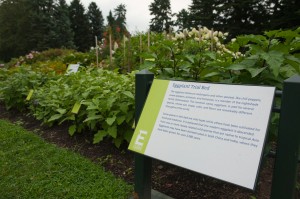Tip of the Week: Edible Garden Features Eggplants
Posted in Gardening Tips on August 23 2010, by Sonia Uyterhoeven
 |
Sonia Uyterhoeven is Gardener for Public Education. Join her each weekend for home gardening demonstrations on a variety of topics in the Home Gardening Center. |
 When I grow vegetables, I count on a wide array of cooking magazines and celebrity chef’s to challenge and stretch my imagination so that I can find creative ways to prepare my bounty.
When I grow vegetables, I count on a wide array of cooking magazines and celebrity chef’s to challenge and stretch my imagination so that I can find creative ways to prepare my bounty.
The other day I was flipping through a cooking magazine featuring Greek cuisine. I perused the magazine with interest, since one of our Celebrity Chef Kitchen Gardens for The Edible Garden was created by Chef Michael Psilakis, owner of Kefi and author of How to Roast a Lamb: New Greek Classic Cooking. (He will present a cooking demonstration at the Conservatory Kitchen on October 16 as part of Fall Finale Weekend.)
Michael’s garden bed is filled with dandelion greens, grapevines, arugula, mint, dill, tomatoes, artichokes, and eggplants. His culinary style is a sophisticated Greek modern fusion that seamlessly combines fish or meat with vegetables, spices, and herbs.
The magazine’s stuffed eggplant recipe (from another Greek chef) caught my interest. Eggplants stuffed with lamb, tomatoes, Parmesan cheese, onion and garlic, seasoned with cinnamon, oregano, cloves and nutmeg. Yum. That’s delicious, culturally complex, comfort food if you ask me.
Eggplants are a favorite of mine in the vegetable garden. A staple of the warm season crops (those planted after the last frost date), eggplants love the heat, and I generally wait until June 1 to set my transplants into warm soil.
Like for all of the vegetables in my garden, I amend the soil with aged cow manure and compost every year to give the young seedlings a steady supply of nutrients and rich, fertile, well-drained soil.
Eggplants are spaced 18 to 24 inches apart. I generally stake them to give them added support. One year I tried a store-bought vegetable ladder that was simple, elegant, and effective. Otherwise, a solid bamboo stake or a small metal cage works fine.
My favorite varieties represent my dark and light side. I find the heirloom ‘Black Beauty’ an indispensable classic, but also hate to go without one of the white varieties such as the aptly named ‘Casper’. The white eggplants are, in my opinion, easier to cook, not as bitter, and have a nice buttery taste.
Life’s not all black and white, and neither are eggplants. They come in a wide array of purples, mauves, whites, greens, oranges, reds, and striped bicolors. They can be the shape of an egg, long and pendulous, or plump and meaty.
As part of The Edible Garden, we have a trial bed in the Home Gardening Center that features eggplants from around the world. Many were collected by Rachel Meyer, a doctoral candidate at the Garden who is researching the history and domestication of the vegetable. She is exploring the medicinal and culinary uses of eggplant, and hopes to promote biodiversity by documenting and collecting heirloom and rare seeds.
Eggplants, indigenous to India, are related to tomatoes, peppers, and potatoes. Some of the eggplants even have spiny stems and foliage. I would have expected our thriving population of rabbits at the Garden to leave them alone, but they have made a home in the eggplant display bed.
Initially, I thought that, given this has been one of the hottest summers on record, the rabbits were paring off the lower leaves of the plant to use the broad, upper foliage as a parasol for protection from the sun. (Some of the rabbits have been seen cooling off under my sprinklers, so this theory wasn’t as far fetched as it might seem.)
However, I took a closer look at the particular species being eaten and noticed it was Solanum macrocarpon, an eggplant that is native to Africa and Asia. While the fruits are used for a sour relish, this particular species is often grown for its edible leaves.
Most members of the Solanaceae family have inedible leaves. In this instance, I needed to read the small, green interpretative signs to learn about this exception. The rabbits just followed their noses.

